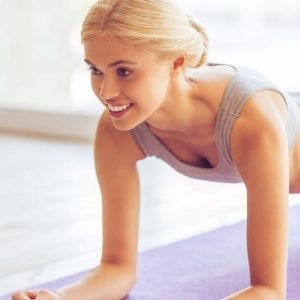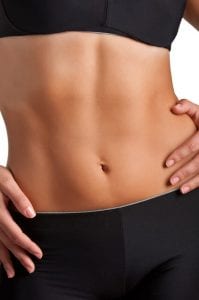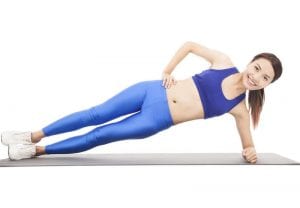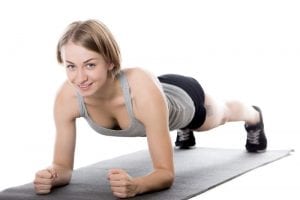 This article will look at the benefits of Plank exercise and the muscles it works. It also contains instructions for the proper way to do the exercise and some Plank variations.
This article will look at the benefits of Plank exercise and the muscles it works. It also contains instructions for the proper way to do the exercise and some Plank variations.
Planks are renowned for being one of the most effective ab exercises you can do.
You may not know that along with being excellent for toning and strengthening the entire midsection, Planks work the glutes and hamstrings, improve posture and balance, and more.
When performed correctly, this simple but surprisingly challenging bodyweight exercise creates tension throughout the entire body while engaging the core.
Improved athletic performance is another plus when all major core muscle groups are activated. And, to get the benefits of the Plank exercise, you will only need to undertake it for 5 to 10 minutes, several times a week.
Keep reading to find out which muscles Planks work.
Table of Contents
Which Muscles are Worked?
The major muscles Planks work are as follows:
- Transverse abdominis –
The deepest of the four abdominal muscles, the transverse abdominis is located at the front and sides of the abs.
- Oblique muscles –
. The obliques are two sets of muscles on the sides of the abdomen
- Rectus abdominis –
The rectus abdominis comprises a vertical muscle on either side of the abdomen. When sculpted, this is the muscle that can give the appearance of a six-pack.
- Glutes –
The glutes are three muscles located in the buttocks.
Next, we will look at the main benefits of Plank exercise.
Benefits of Plank Exercise
There are many benefits of Plank exercise, including the following:
- Strengthens and tones the core –
Planks offer one of the most reliable ways to tone and strengthen the core muscles, including the abs, back, hips, and buttocks.
Done regularly in combination with other body strength exercises, cardio, and the right diet, and you will be on your way to getting a six-pack.
- Increases flexibility –
Another of the benefits of Plank exercises is that they will make you more flexible.
This is because they stretch all of the body’s posterior muscles, from the hamstrings down to the arches of the feet and even the toes.
- Improves posture –
Because they work the entire core when done consistently, Planks will develop your abs and your trunk from its pelvic girdle to shoulder girdle. When these muscles are strong, you will naturally sit and stand more upright, with a straighter back.
With good posture, you will look slimmer, taller, and younger. Your respiratory and nervous systems will function more efficiently, as will your digestive system.
- Helps build stronger bones –
Planks are a weight-bearing exercise, and weight-bearing exercise is one of the best means of building stronger bones, which in turn helps to prevent osteoporosis.
- Reduces the risk of back pain and injury –
Planks can lower the likelihood of experiencing back pain and injury. This is because they build and strengthen the muscles in this area without overly stressing the spine and hips.
When these muscles are strong, they will help you stay upright so that your back doesn’t have to do all the work.
An article published by the American Council on Exercise backs these claims.
- Alleviates mild stress –
Planks stretch out muscle groups that contribute to body tension. As a result, done regularly, they promote a feeling of relaxation, which in turn helps to improve overall mood.
- Boosts the metabolism –
The intense nature of Plank exercise assists weight loss because it burns more calories both during and after your workout compared to many other ab exercises such as Crunches and Sit-Ups.
Next, we will look at the proper way to do the Plank exercise.
Proper Way to do the Plank Exercise
No equipment is required to do Planks. All you need is enough free floor space to lay down flat.
But to get the most benefit, it’s essential to learn the proper way to do the Plank exercise.
I will outline the steps below.
1. Lie face down on the floor with your upper body resting on your forearms, your shoulders positioned above your elbows, and your palms flat on the floor. (You can rotate your elbows to a 45-degree angle and clasp your palms together if this feels more comfortable.)
Your legs should be straight out behind you. Start with your feet about shoulder-width apart or wider if you need extra stability.
As you become stronger, move your feet closer together.
2. Assume a Push-Up position, lifting your body upwards so that your forearms and toes support your weight.
Keep your back flat and your head, neck, and spine in a straight line.
3. Contract your abdominal muscles without lowering your stomach or raising your hips.
The easiest way to ensure the latter is to tilt your pelvis towards the floor.
To begin, hold this position for 20 seconds, and start with 3 to 5 planks.
As you become fitter and stronger, hold the Plank position for longer until you reach 60 seconds.
You can also do more Planks if desired.
NB: Don’t hold your breath. Breathe slowly and steadily throughout the exercise.
Engage your abs and glutes.
Don’t allow your lower back to arch or your upper back to round, and don’t lift your hips or let them sag.
Next, we will look at some Plank Variations for people who are new to them and those who are advanced level. Aim to do each exercise for a minimum of twenty seconds to start.
Variations
If you find regular Planks too hard, start with modified Planks.
Modified Planks involve keeping your knees on the floor rather than balancing on your toes. 
If you’ve been doing Planks for a while, you may want to increase the challenge by targeting other muscles and further strengthening your core.
Following are some Plank exercise variations for you to try.
Side Planks –
To do a Side Plank, lie on your right side, then lift your body upwards to support your upper body on your right forearm, with your feet, knees, and thighs stacked on top of each other.
You can keep your left arm by your side or place your left hand on your hip. Along with engaging more core muscles, this move will target your obliques.
Turn over and repeat the movement to work your left side.
Planks with Side Arm Raises –
Assuming a Push-Up position, lift your right arm up and out to the side until it is at shoulder height.
Maintain this position for 1 to 2 seconds, then lower your arm to return to your starting position. Repeat this movement, lifting your left arm.
Planks with Front Arm Raises –
Commencing from a Push-Up position, lift one arm to the front until it is in line without your shoulder.
Hold this position for 1 to 2 seconds before returning to your starting position.
Repeat this movement to work your left side.
Forearm Planks to Push-Up –
Assume a Push-Up position, then lower your right forearm to the floor, then your left forearm so that you are in a Plank Position.
Return to your starting position by first lifting your right arm, then your left.
Repeat these movements, leading with your left forearm.
Spiderman Planks –
Commencing from a Push-Up position, bend your right knee and bring it forward as close to your right elbow as you can.
Hold this position for 1 to 2 seconds before returning to your starting position.
Repeat this movement, leading with your left knee.
Alternating Leg Lift Forearm Planks –
Starting from a Plank position, keep your right leg straight and lift it until it is above hip height.
Hold this position for 1 to 2 seconds before returning to your starting position.
Repeat this movement to work your left side.
Planks with Shoulder Taps –
Assume a Push-Up position, and without allowing your weight to shift, tap your left shoulder with your right hand.
Immediately return to your starting position and tap your left hand to your right shoulder.
Final Thoughts on the Benefits of Plank Exercises
As you can see, the benefits of Plank exercise are numerous. This being so, it is little wonder it is so popular with personal trainers and fitness fans alike. 
If you are new to exercise, take it slow, and do modified Planks until your strength and fitness improve enough for you to move on to regular ones.
It’s fine if you can only manage to hold the position for 10 seconds at first. Try adding one second more every day or two, and build up from there if you wish.
After doing them for a while, try some of the Plank exercise variations above. Just remember to maintain the correct form to get the most from the exercise.
If you feel your form faltering, stop, rest, then try again.
You may also like to read this article containing instructions for 10 Bosu Ball ab exercises that will transform your core.
For more information, you may also like to read this article on the benefits of strong core muscles.
If you’d prefer to use a machine to tone and strengthen your core, check out the Fitlaya Fitness Ab Machine.
It is affordable, has a very generous user weight limit, folds to store, and can also tone the abs, thighs, and upper body.

